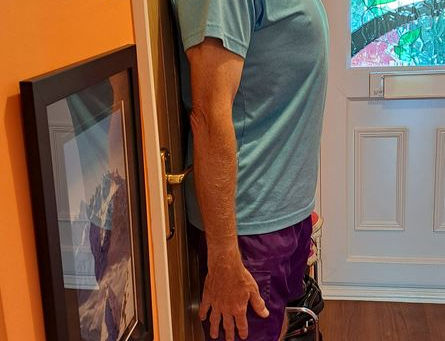top of page
DAVID WATTS MASSAGE THERAPY
Massage to transform your life
07495 301 440
davidwattsmassage@gmail.com
Search


Trigger Point Therapy Course in Chiang Mai, Thailand
#RSMInternationalAcademy #davidwattsmassage I recently attended a trigger point therapy course and a sports massage course over a period of 5 days in Chiang Mai, Thailand, to enhance my massage skills. The courses were conducted by RSM International Academy which is located above Spa Mantra, a short distance north of the old city wall. Teaching the course was Hironori Ikeda, an expert in sports medicine. RSM International Academy provides specialised massage focused on pain r
davidwatts3
Oct 20, 20252 min read


Are You Susceptible to Rounded Shoulder Posture (RSP)?
#davidwattsmassage RSP refers to a postural condition where the shoulders are positioned forward, deviating from the ideal alignment with...
davidwatts3
Sep 10, 20256 min read


Unwinding with a Hand Massage at Rewind!
#rewindfestival #davidwattsmassage #raynormassage Warming up the hand at the beginning of the hand massage Whilst queueing up on Sunday...
davidwatts3
Aug 19, 20252 min read


Easter Massage in the Lakes
Just before Easter I had a request from another David in my walking club ( Ibex Mountain and Hill Walking Club ) for a massage at Rydal...
davidwatts3
Apr 24, 20251 min read


April is Stress Awareness Month
Stress Awareness Month is an annual event in the UK observed every April. It is dedicated to increasing public awareness about the causes...
davidwatts3
Apr 23, 20253 min read


Thailand - The land of massage
I recently visited Thailand, one of the goals being to experience Thai oil massages and picking up tips that would benefit my own massage...
davidwatts3
Feb 5, 20251 min read


Gift Vouchers now available!
With the festive season fast approaching, David Watts Massage Therapy is now offering gift vouchers. Vouchers cost £40 and entitle the...
davidwatts3
Dec 5, 20241 min read


Hands-free Deep Tissue Massage Course
As a massage therapist, it's very important not to overwork your hands. With this in mind, I recently attended a one-day "hands-free"...
davidwatts3
Nov 2, 20241 min read


What are the benefits of a head massage?
A Raynor head massage can involve a large number of different strokes all over the face and scalp. It is a good way of relaxing a client...
davidwatts3
Oct 12, 20245 min read


How are new clients diagnosed for tension?
I specialise in Raynor Massage. Being a holistic massage, I spend 15 - 20 minutes diagnosing all of a client's body to find out where...
davidwatts3
Sep 12, 20242 min read


How does Raynor Massage differ from other popular massage styles?
Some of the most popular massage styles in the UK are Swedish massage, deep tissue massage, and sports massage. For the purposes of this...
Josh Elvin
Sep 11, 20246 min read


What is the Difference Between Sports Massage and Deep Tissue Massage?
What is the Difference Between Sports Massage and Deep Tissue Massage? When going for a massage two of the popular options are Sports...
Josh Elvin
Sep 11, 20247 min read


Relieving Tension Headaches and Migraines
Tension headaches and migraines are often triggered by stress, prolonged periods of concentration, or neck strain (e.g. looking down at a...
Josh Elvin
Sep 11, 20241 min read


Alleviating Tension From Hands
If you suffer from stiff hands Raynor Massage has several techniques which may help to loosen them. Each finger/thumb contains several...
Josh Elvin
Sep 11, 20241 min read


The Power of Raynor Massage
In the Jan/Feb edition of the Windsor & Maidenhead Local magazine I've written an article giving an overview of Raynor Massage. Briefly...
Josh Elvin
Sep 11, 20241 min read


Raynor Massage Advanced Course (September 2023)
I recently attended one of the Raynor Massage advanced courses, held in Putney, London and taught by the creator Brandon Raynor himself....
Josh Elvin
Sep 11, 20243 min read


What is a Muscle Knot?
A muscle "knot" is a small, hard, sensitive area where muscle fibres or fascial tissue have tightened and stuck together. It feels like a...
Josh Elvin
Sep 11, 20241 min read


Tension and Raynor Bands
Most of us have some level of stress in our bodies. Stress can be physical or emotional. It can be the result of a traumatic event or can...
Josh Elvin
Sep 11, 20242 min read


How does massage relieve or prevent Tension Headaches?
The most common type of headache is the Tension Headache. Symptoms include a dull, aching pain on both sides of the head, face, or neck,...
Josh Elvin
Sep 11, 20242 min read


What is Deep Tissue Massage?
Over time our muscles and fascia (connective tissue) can become tense. Muscle tension is when our muscles stay partially contracted for a...
Josh Elvin
Sep 11, 20242 min read
bottom of page